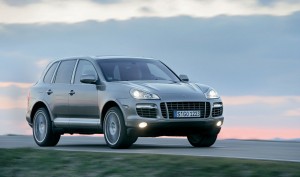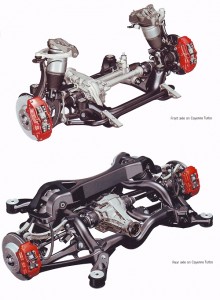Air or steel springs – the Porsche Cayenne
The other day I was given some interesting Porsche books.
From any other car manufacture, they wouldn’t be ‘books’ but instead be new car brochures, but Porsche really do produce full books on their models. (Incidentally, these are always worth buying – a friend who sells them on www.ebay.com.au has the user name q993.)
One of the books was on the Porsche model that I believe to be a complete sell-out of everything that Porsche has always stood for – the 2.2 tonne Cayenne.
(And these thoughts were confirmed when I looked at the car’s quoted fuel economy – a combined cycle of 15.8 litres/100km for the manual Cayenne S. Even the 306 km/h 911 GT3 is quoted at 12.9 litres/100km!)
Anyway, be that as it may, what interested me in the Cayenne publication were the details on the suspension. Two different types of springs are used – air suspension on the Cayenne Turbo and conventional steel springs on the other Cayenne models.
According to the Porsche book, when the adjustable air suspension is set at its normal ride height, the Cayenne Turbo’s front suspension has 102mm of bump travel and 118mm of droop travel, and the rear suspension has 124mm of bump and 125mm of droop.
Now from those bare stats, some very interesting stuff can be worked out. The first is where the car sits within its suspension travel – what’s called its static deflection.
If you draw a little diagram, you’ll soon see that the greater the available droop travel, the more suspension travel the car must “use up” just sitting there. So in fact, the amount of available droop is also the static deflection.
The Cayenne Turbo has a static deflection of 54 per cent at the front and 53 per cent at the back.
Therefore, Porsche engineers consider it (slightly) more important that the wheels stay on the ground as they pass through depressions and holes, than they consider it important that bumps are absorbed.
However, air springs are usually designed to be non-linear, so as they are compressed, the springs could be expected to gain stiffness at an increasing rate. Therefore, it makes sense to provide a static deflection more than half way up through the spring’s travel.
If the springs were linear in their behaviour, we could calculate a natural frequency of the suspension. Although we guess they are not linear, let’s do that calculation anyway. (As covered here, the natural frequency of the suspension is easily calculated from just the static deflection.)
For the air suspension Cayenne Turbo, the figures are 1.45Hz for the front and 1.41Hz for the back. Clearly those numbers are very similar, which is interesting when it is more normal to make the rear suspension stiffer (a higher natural frequency). Incidentally, these frequencies are much more in the category of ‘cars’ rather than ‘sports cars’.
And what about the steel spring Cayennes? At the front they use a static deflection of 50 per cent, the smaller proportion of suspension travel used up perhaps agreeing with the idea that the air-springs are likely to be a lot more non-linear than the steel springs.
The front natural frequency is 1.41Hz – very similar to the 1.45Hz of the air spring cars.
And at the back? The steel spring cars use up only 42 per cent of the spring travel in static deflection, and as a result the natural frequency is 1.6Hz – clearly much higher than the rear suspension air spring’s 1.47Hz.
So what’s going on – why is the steel spring’s rear suspension so out of kilter in natural frequency (and therefore in the percentage of travel used up by the static deflection)?
The answer is that the rear air springs can be load-levelled by the system pumping more air into them. The steel spring car cannot do this, so Porsche engineers need to leave enough ‘room’ for the steel spring to settle when a big load is placed in the back.
The result is that the rear suspension must be stiffer, with all the negative light-load ride and handling consequences.
This table summarises the released and calculated data:
|
|
|
Cayenne Turbo (air suspension) |
Cayenne (steel suspension) |
|
Front |
|
|
|
|
Total travel |
220mm (~8.7 inches) |
220mm (~8.7 inches) |
|
|
Bump travel |
102mm (~4.0 inches) |
104mm (4.1 inches) |
|
|
Droop travel |
118mm (~4.6 inches) |
116mm (4.6 inches) |
|
|
Static deflection |
54 per cent |
53 per cent |
|
|
Natural frequency |
1.45Hz* |
1.47Hz |
|
|
|
|
|
|
|
Rear |
Total travel |
249mm (~9.8 inches) |
233mm (~9.2 inches) |
|
Bump travel |
124mm (~4.9 inches) |
135mm (~5.3 inches) |
|
|
Droop travel |
125mm (~4.9 inches) |
98mm (~3.9 inches) |
|
|
Static deflection |
50 per cent |
42 per cent |
|
|
Natural frequency |
1.41Hz* |
1.60Hz |
*But air springs probably non-linear
I think two things come out of this.
The first is that it’s interesting that where the choice is available (ie on the air spring car), Porsche has chosen to slightly emphasise droop travel at the expense of bump travel. (It’s true that the air spring is very likely to be non-linear, but the engineers could still have chosen to set the static deflection differently.)
The second interesting aspect is that this data shows how there are real design advantages in using self-levelling air suspension. Put simply, the car can be configured for the lightest loads it will carry, without at the same time disadvantaging it when it comes time to carry a large load. That is just not the case with the conventional steel spring suspension, where the requirements for stiffer rear springs cause a real-world disadvantage in ride and handling.
Finally, two points to ponder.
The Cayenne Turbo’s air suspension has automatic on-the-move adjustment of ride height. When speed exceeds 125 km/h, the ride height drops by 27mm. At 210 km/h the ride height drops another 11mm. Therefore, static deflection at 210 km/h is (118 + 27 + 11 =) 156mm. This results in a calculated natural frequency of just 1.27Hz – a very soft suspension indeed! I assume that in this situation the variable dampers are automatically firmed-up a lot, but it’s interesting to think of how soft the suspension becomes at speed.
And the other interesting idea is that the toe changes that occur as the car moves through its suspension travel must be kept absolutely minimal. Otherwise, the 38mm change in ride height at over 210 km/h could lead to some spooky handling – imagine a few millimetres of toe-out on the front and rear wheels at the car’s top speed of 266 km/h…

 Julian Edgar, 50, has been writing about car modification and automotive technology for nearly 25 years. He has owned cars with two, three, four, five, six and eight cylinders; single turbo, twin turbo, supercharged, diesel and hybrid electric drivelines. He lists his transport interests as turbocharging, aerodynamics, suspension design and human-powered vehicles.
Julian Edgar, 50, has been writing about car modification and automotive technology for nearly 25 years. He has owned cars with two, three, four, five, six and eight cylinders; single turbo, twin turbo, supercharged, diesel and hybrid electric drivelines. He lists his transport interests as turbocharging, aerodynamics, suspension design and human-powered vehicles.



on November 5th, 2008 at 9:27 am
Your calculations are based on the concept that there is no preload on the springs at full droop.
If the springs have any preload (and they no doubt will to avoid them dislocating), then the actual natural frequency will be lower than your calculation.
on November 6th, 2008 at 2:24 pm
I agree with Matt. The “full droop” has more to do with the limit of travel for the damper than full expansion of the spring.
Speaking of suspension design, I found this interesting paper at http://www.rqriley.com/suspensn.htm . Apparently, ride comfort is perceived as comfortable if the natural frequency is between 1 and 1.5 Hz. At 2 hz it is perceived as “harsh”, but this is often tolerated in full-on sports cars. The paper particularly discussed implications for Low-Mass vehicles, for which suspension design is especially challenging.
on November 6th, 2008 at 6:37 pm
Matt, yes I take that point which to be honest, I’d not thought of. (However, it makes my recumbent trike suspension stats even better than I stated in those articles!)
Ken, full extension of the spring is not considered when calculating natural frequency. It’s just compression, which takes into account weight and spring rate (and spring leverage ratio).
However, I don’t think the overlooking of preload changes the final four points much, if at all.
on November 7th, 2008 at 5:45 pm
Julian, I agree with the points you were making – steel springs do indeed have their limitations. However, the formula giving natural frequency derived entirely from static deflection is only valid if the springs start from fully extended. Of course, if you already know the spring rate, and the leverage of the suspension system, accurate calcs can be made without bothering about pre-load.
on August 8th, 2010 at 10:31 am
One consideration to take place on choosing your car is the fuel economy.Especially nowadays,where gas prices almost increase everyday.It’s a practical way as you will have your car for a long time.
on September 19th, 2010 at 1:29 pm
It is interesting to read all the write up published here. Yes I am a late comer to this forum, anyway I am the owner of a basic cayenne with steel spring suspension and had the shock absorber replaced with Koni FSD. I found that driving over an undulating road the SUV is bouncy and is very uncomfortable. This may be the result of a large difference of natural frequency between the front and rear suspension.
Can any body suggest on how to improve the situation please.